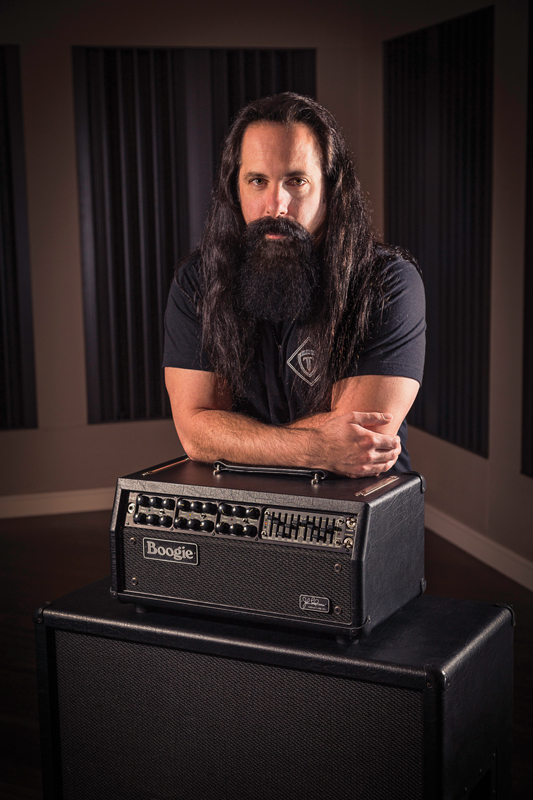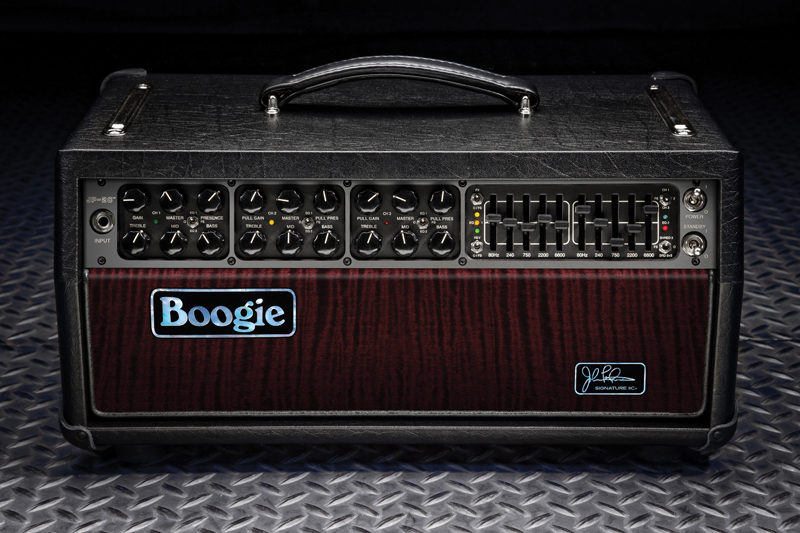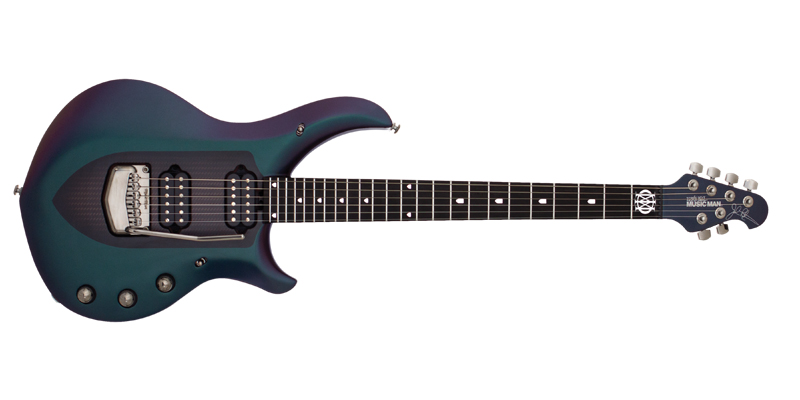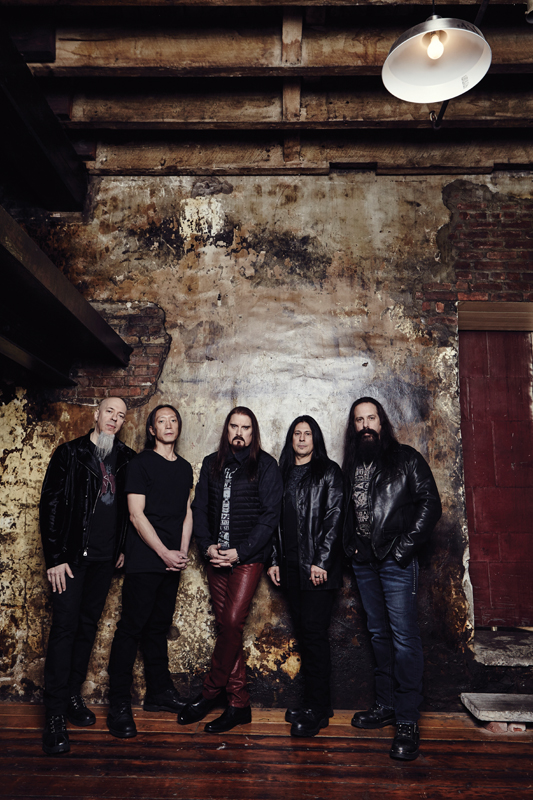Interview: John Petrucci – Pet Sounds
Dream Theater’s latest offering, The Astonishing, is just that – a two-hour concept album telling an engrossing story, with music written by guitarist John Petrucci.

There’s no two ways about it: Dream Theater do not instigate ambivalence. Fans of the band, some of rock’s most loyal and passionate, will point to album sales in excess of 12 million and Grammy nominations, whilst revelling in oceans of music revered for its diamond cutter-like precision and lyrical complexity. Naysayers will revile the quintet for those same reasons – what’s with all those unnecessarily complex swarms of notes?
However, even the staunchest of haters will acknowledge the brilliance of guitarist John Petrucci. If his stunning technique, apparent in his smooth and emotive feel, crushing syncopated riffs and speed-of-light solo runs that defy both belief and gravity, doesn’t excite, the ever-growing selection of mouth-watering signature Music Man guitars surely shall.
The concept album, too, is an entity that many can embrace or dismiss with equal ferocity but, as Tommy, The Wall and even the Rush masterpiece 2112 have proved, it’s possible for a band to present an absorbing story alongside some pretty special music. With their 13th studio opus, The Astonishing, Dream Theater hope to tread the same ground, not only by setting an original story to music but also by playing the entire composition on stage in a pre-planned show.
“It’s been a very long, involved, in-depth and complex album project for us,” Petrucci tells G&B with a laugh. “The process started around two and a half years ago, the idea to do a concept album based on an original story and write a full show’s worth of music.”
As he goes into more detail, we begin to appreciate just how elaborate the process must have been. Not only did he write the story and most of the music and lyrics, he also produced the album. Oh, and he played a bit of guitar too.

“It’s set 300 years into the future, in this world where music isn’t made by humans but by artificial intelligence, so it’s lost all its depth,” he begins. “Nobody plays music anymore, as there’s no reason to do so. The aristocracy rules over the inhabitants and things go back to the feudal times – emperors and empires – so it’s kind of retro-future.
“Music plays a big role in the story and I also called upon some common themes,” he continues. “There’s a strong brother relationship, forbidden love and a good against evil element, too, the need for some kind of saviour to inspire the oppressed society to rise up against the establishment.”
Spread over 34 tracks, the music is dense and complex with classic DT hallmarks front and centre: a huge guitar tone, some wonderful melodies from keyboard wizard Jordan Rudess, and, yes, James LaBrie’s eccentric vocals.
How did John go about marrying the story with the music? “In order for this to be written in the best way, as far as the focus it would require to make this work as a show, we determined that Jordan and I would write together,” Petrucci explains, warming to the theme.
“I took the story I had written and the musical bits Jordan and I had collected and, in a very complex and methodical way, mapped everything out over the course of two acts. As we were writing the music, Jordan and I would demo the songs, so they basically existed as guitar and piano demos. Jordan would lay down a synth line for the bass part and we’d be adding choir and string parts: we had the best over- and under-produced demos, albeit without drums and vocals,” Petrucci laughs.
Dream Theater have always worked with elaborate soundscapes, but this time Petrucci felt that some genuine orchestration was required. Cue a call to noted conductor David Campbell, who has waved his baton for the likes of Adele, Beyoncé and Beck.
“We often have samples of strings and choirs going in our music, it’s part of our sound,” says Petrucci. “In a lot of ways, the writing process as far as that’s concerned wasn’t too different, it was just now they were going to be all performed by the real deal.
“So, we had all this synth orchestration and MIDI information that we’d send to David as it was completed,” Petrucci continues. “He did a combination of taking that and fleshing it out for a real choir and orchestra, and adding his own arrangements in the places where we had nothing. He’d also determine which of it was realistic, as sometimes the range was wrong for certain instruments.
“I will say that, like every step of this process, it was a massive task. There was so much music for him to transcribe and to flesh out, and so many recording sessions that had to be set up; strings, brass, percussion, choirs and all sorts of things. But I really enjoyed the process.”
We’d challenge anyone to listen to, for example, the lovely Heaven’s Cove and not be moved by the mournful choral arrangement; it’d give a table goosebumps. However, let’s not forget that underneath all this is John Petrucci the guitarist. Did he ever feel he was getting lost? He pauses for a second or two…

“I think that, as a guitar player, one of the important things that I needed to keep sight of was that the real orchestration would take up a lot of space and that the album could have been swallowed up by a very symphonic sound. It’d be like Dream Theater-lite,” he concedes. “So my goal, not only as the guitar player but also as the producer, was to make sure the band retained a hard rock and metal sound through it all.”
We’d suggest that he’s got that balance just about right. Taking Ravenskill as another example, an ethereal piano and vocal intro is soon dispelled by a huge guitar riff underpinned by Mike Mangini’s machinegun drums. Was that moment akin to John saying ‘Hello, I’m still here!’?
“I’m always going to play the way I play, so that was always going to be there. It was how it was utilised that was so important,” says John, succinctly. Presumably, there’s more to the process of learning such complex material and getting it up to scratch than John and the band huddling around an iPod.
“Yeah, learning it all is not easy!” he confirms. “First off, it’s the volume of material, so remembering what I played, recalling the fingerings, committing that to memory… it takes hours. It’s one thing to learn it, but it’s another to actually be able to perform it.
“The great thing about this band is that everybody does their homework,” he continues. “So we came into rehearsals and were sure that every band member would know the music. We might not play it perfectly right off the bat, but everybody would be ready and prepared. With this album, it needed to flow like a continuous show, so there was a bit more pressure to be able to seamlessly play everything at once.”
There are some real guitar gems to be found in The Astonishing, and we mention a few tracks to John. The beautifully melodic lines in Saviour In The Square and Begin Again contradict any notion of technicians being robotic.
“I approach it like a singer would,” he clarifies. “I’m a lyricist, so I’m constantly writing vocal melodies. The melodic ins and outs of chord progressions are always at the forefront of my thinking, so when I’m playing guitar in songs like that, where it’s really the voice, I’m almost singing it to myself and it comes out of the guitar.”
And would that be the best method for beginners to tackle the same style? “Beginners might not know where those notes are on the guitar or how to pull that off,” he suggests, “but if they were to play some progressions and, assuming they were uninhibited, just sing melodies they could very easily come up with something that was flowing and natural.”
As with most players who are able to shred with musicality, Petrucci also has some sage advice for those wishing to improve their speed technique. We use sections of Moment Of Betrayal and A New Beginning as examples of where John really goes for it, but he already has an answer for us. “To me, speed is always at its most effective and impressive when executed cleanly,” he says, with a certain amount of steel in his voice.
“If you’re going to do something within a song that uses speed to drive a section forward or to create some real positive energy, then the cleaner and more precise it is, the more rhythmically accurate it is – that’s when speed is at its most musical.
“So, for people practising that type of thing, I’ve always advocated working with some sort of solid reference, whether it be a metronome or drum machine, and working on subdivisions of beats. So when you play fast, you can lock it in to some sort of relevant subdivision within the music so that it doesn’t just sound like nonsense. There’s nothing worse than sloppy fast playing,” he concludes with what looks almost like a sneer.
The extravaganza that is The Astonishing Live will be premiered in Blighty, with two shows at the London Palladium booked for February, thus bringing the whole process to a close of sorts. Presumably, the prospect of playing the material live will require yet more rehearsal time.
“Well, prior to going on tour I’ll be focused on just playing those songs, so any technical challenges within them will provide me with sufficient practice material to get my chops where they need to be,” says Petrucci. “In a lot of ways, I don’t really have to do more than that, as the music itself becomes a practice schedule, and that’s really cool. Anyway, I can’t go for too long without playing guitar – it’s part of my personality, I guess.”
Boogie Nights
Petrucci used just one amp for the entire The Astonishing album – a very special amp…

“I have a signature Boogie coming out, and I used it on the whole album,” says Petrucci, with the air of a proud father. “It’s called the JP-2C, and it’s basically a reissue of Boogie’s Mark IIC+, but modernised. [Mesa/Boogie head honcho] Randall Smith designed it, and tonally it’s the first time they’ve done a real reissue of the IIC+, down to the transformer and circuit board. It just sounds unbelievable and if you like what you hear on the album, it’s all that amp.”

The original 60-watt Boogie MkIIC+ is especially revered amongst tonehounds, not just because of its massive crunch tone, courtesy of juiced-up IIC lead circuits, but also due to their rarity thanks to a criminally short production period. Introduced in February 1984, they were usurped just 13 months later by the Mark III.
“It’s a dream come true and I’ve just loved Boogie forever, used them on every album and every tour,” Petrucci continues, his enthusiasm obvious. “I’m over the moon with it and, with the exception of the limited run of Carlos Santana Mark Is that they did [2013’s King Snake combo – Ed], this is Boogie’s first real signature amp, so I’m truly honoured.”
Music Men
Petrucci’s astonishingly modest guitar arsenal

John Petrucci has been involved with Music Man for many years now, and it’s no surprise to learn that he used a number of his signature axes on the sessions for The Astonishing.
“I used my Music Man Majesty for the whole album, both six and seven strings,” he assures us, “except for one song, The Path That Divides, where I used my JP15 – and I really think you can hear the difference. There’s a little more midrange to it.”
Each year, Petrucci and MM conspire to introduce a new JP model, and we were particularly smitten with 2015’s JP15. Alongside a pair of signature DiMarzio Illuminator humbuckers, the guitar features a mahogany body topped with a slab of roasted maple – a first for a JP model. Also new on the 2015 model was the roasted maple neck and fingerboard, so we asked John to talk about these additions.

“I don’t really play too many guitars with plain maple necks; I usually prefer a mahogany or a painted neck, something like that,” he begins. “But the roasting process brings out all the detail in that maple and gives it that dark stain. It’s warm and inviting and, to me, when you’re playing and looking down, how a guitar hits you visually is really important. It’s inspiring.”
And what about the inevitable new signature guitar for 2016?
“The JP16 was recently launched at NAMM and we’re really excited about it. It’s based on the JP15, but we’re bringing the forearm scoop back from the original JP and it’s actually going to have a Floyd Rose too, which is something we haven’t ever done on my model. It’s a deep black Mercedes colour, really sleek, and it’s going to be awesome.”
Check out Dream Theater’s official trailer for their new album The Astonishing – out now on Roadrunner Records.

